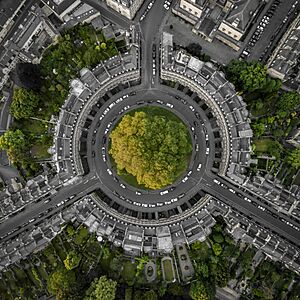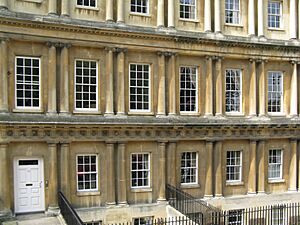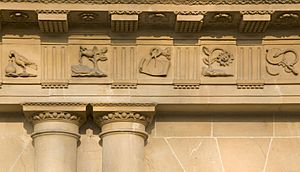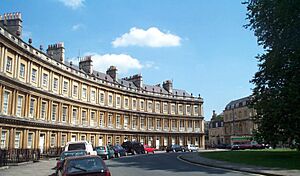The Circus, Bath facts for kids
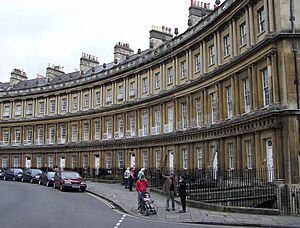
A view of The Circus
|
|
| Former name(s) | King's Circus |
|---|---|
| Maintained by | Bath and North East Somerset Council |
| Addresses | 1-30 The Circus |
| Postal code | BA1 2 |
| Coordinates | 51°23′10″N 2°21′50″W / 51.386°N 2.364°W |
| Construction | |
| Construction start | 1754 |
| Completion | 1768 |
| Other | |
| Designer | John Wood, the Elder |
| Status | Grade I listed |
The Circus is a famous ring of large houses in the city of Bath, Somerset, England. It forms a perfect circle with three entrances. Designed by the architect John Wood, the Elder, it was built between 1754 and 1768. It is a great example of Georgian architecture, which was popular in the 1700s. The word "Circus" comes from Latin and means a ring or circle. These buildings are so special that they are protected as a Grade I listed building.
The Circus is split into three equal parts. There is a grassy area in the middle. Each part of the building faces one of the three entrances. This makes sure that a beautiful, classic-looking side of the building is always seen straight ahead.
History of The Circus
The Circus was first called the King's Circus. It was designed by a famous architect named John Wood, the Elder. He believed that Bath was once a main spot for Druids in Britain. Druids were ancient Celtic priests.
Wood studied Stonehenge, a famous ancient stone circle. Stonehenge's outer bank is about 325 feet across. Wood designed The Circus to be very similar, with a diameter of 318 feet.
Sadly, John Wood the Elder died less than three months after building started. His son, John Wood, the Younger, finished the project. He followed his father's original plans exactly. The first agreements to rent parts of the Circus were made between 1755 and 1767.
The Circus was a big part of John Wood the Elder's dream. He wanted to make Bath look like a classical Roman city. He also designed Queen Square nearby. Many people think The Circus is his best work.
A famous painter, Thomas Gainsborough, lived at Number 17 from 1758 to 1774. He used part of his home as a studio to paint portraits. Admiral Sir Richard Bickerton and his family lived at Number 15 in the early 1800s.
During World War II, Bath was bombed on April 25-26, 1942. This event was called the Bath Blitz. A bomb hit The Circus, destroying some houses. But don't worry, these houses were rebuilt to look exactly like the originals.
A historian named Dan Cruickshank chose The Circus as one of his top five buildings. This was for a TV show called Britain's Best Buildings in 2002.
How The Circus Was Designed
The buildings use three main styles of Classical orders. These are like different types of columns and decorations. They are the Greek Doric, Roman/Composite, and Corinthian styles. They are stacked one above the other on the curved walls.
The edge of the Doric style part has cool designs. It has alternating triglyphs and 525 pictures. These pictures include snakes, boat symbols, and signs for arts and sciences. There are also symbols from Freemasonry. The top wall has stone acorn shapes as decorations.
If you look at The Circus from above, it forms a key shape. This shape is a special symbol used in Freemasonry. It is similar to symbols found on many other buildings designed by Wood.
The middle area of The Circus was first paved with stone. It covered a water tank that supplied water to the houses. In 1800, the people living there turned the middle into a garden. Now, it's a grassy area with five large plane trees. These trees are thought to be from around 1820. They are part of why The Circus is a protected Grade I building.


